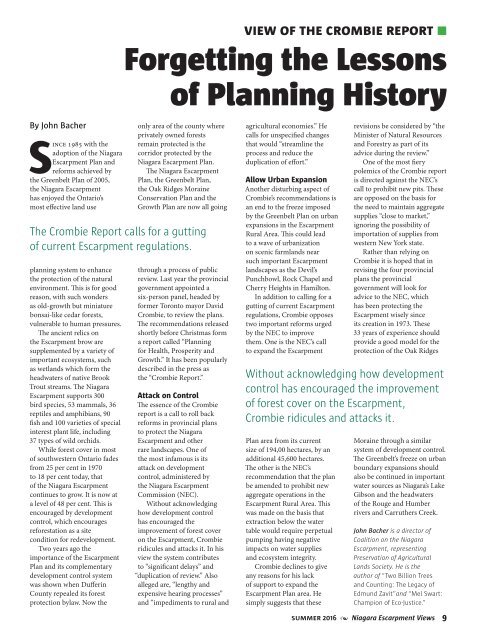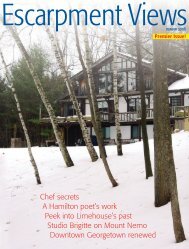Niagara Escarpment Views - Autumn 2016
Create successful ePaper yourself
Turn your PDF publications into a flip-book with our unique Google optimized e-Paper software.
View of the Crombie Report n<br />
Forgetting the Lessons<br />
of Planning History<br />
By John Bacher<br />
Since 1985 with the<br />
adoption of the <strong>Niagara</strong><br />
<strong>Escarpment</strong> Plan and<br />
reforms achieved by<br />
the Greenbelt Plan of 2005,<br />
the <strong>Niagara</strong> <strong>Escarpment</strong><br />
has enjoyed the Ontario’s<br />
most effective land use<br />
planning system to enhance<br />
the protection of the natural<br />
environment. This is for good<br />
reason, with such wonders<br />
as old-growth but miniature<br />
bonsai-like cedar forests,<br />
vulnerable to human pressures.<br />
The ancient relics on<br />
the <strong>Escarpment</strong> brow are<br />
supplemented by a variety of<br />
important ecosystems, such<br />
as wetlands which form the<br />
headwaters of native Brook<br />
Trout streams. The <strong>Niagara</strong><br />
<strong>Escarpment</strong> supports 300<br />
bird species, 53 mammals, 36<br />
reptiles and amphibians, 90<br />
fish and 100 varieties of special<br />
interest plant life, including<br />
37 types of wild orchids.<br />
While forest cover in most<br />
of southwestern Ontario fades<br />
from 25 per cent in 1970<br />
to 18 per cent today, that<br />
of the <strong>Niagara</strong> <strong>Escarpment</strong><br />
continues to grow. It is now at<br />
a level of 48 per cent. This is<br />
encouraged by development<br />
control, which encourages<br />
reforestation as a site<br />
condition for redevelopment.<br />
Two years ago the<br />
importance of the <strong>Escarpment</strong><br />
Plan and its complementary<br />
development control system<br />
was shown when Dufferin<br />
County repealed its forest<br />
protection bylaw. Now the<br />
only area of the county where<br />
privately owned forests<br />
remain protected is the<br />
corridor protected by the<br />
<strong>Niagara</strong> <strong>Escarpment</strong> Plan.<br />
The <strong>Niagara</strong> <strong>Escarpment</strong><br />
Plan, the Greenbelt Plan,<br />
the Oak Ridges Moraine<br />
Conservation Plan and the<br />
Growth Plan are now all going<br />
The Crombie Report calls for a gutting<br />
of current <strong>Escarpment</strong> regulations.<br />
through a process of public<br />
review. Last year the provincial<br />
government appointed a<br />
six-person panel, headed by<br />
former Toronto mayor David<br />
Crombie, to review the plans.<br />
The recommendations released<br />
shortly before Christmas form<br />
a report called “Planning<br />
for Health, Prosperity and<br />
Growth.” It has been popularly<br />
described in the press as<br />
the “Crombie Report.”<br />
Attack on Control<br />
The essence of the Crombie<br />
report is a call to roll back<br />
reforms in provincial plans<br />
to protect the <strong>Niagara</strong><br />
<strong>Escarpment</strong> and other<br />
rare landscapes. One of<br />
the most infamous is its<br />
attack on development<br />
control, administered by<br />
the <strong>Niagara</strong> <strong>Escarpment</strong><br />
Commission (NEC).<br />
Without acknowledging<br />
how development control<br />
has encouraged the<br />
improvement of forest cover<br />
on the <strong>Escarpment</strong>, Crombie<br />
ridicules and attacks it. In his<br />
view the system contributes<br />
to “significant delays” and<br />
“duplication of review.” Also<br />
alleged are, “lengthy and<br />
expensive hearing processes”<br />
and “impediments to rural and<br />
agricultural economies.” He<br />
calls for unspecified changes<br />
that would “streamline the<br />
process and reduce the<br />
duplication of effort.”<br />
Allow Urban Expansion<br />
Another disturbing aspect of<br />
Crombie’s recommendations is<br />
an end to the freeze imposed<br />
by the Greenbelt Plan on urban<br />
expansions in the <strong>Escarpment</strong><br />
Rural Area. This could lead<br />
to a wave of urbanization<br />
on scenic farmlands near<br />
such important <strong>Escarpment</strong><br />
landscapes as the Devil’s<br />
Punchbowl, Rock Chapel and<br />
Cherry Heights in Hamilton.<br />
In addition to calling for a<br />
gutting of current <strong>Escarpment</strong><br />
regulations, Crombie opposes<br />
two important reforms urged<br />
by the NEC to improve<br />
them. One is the NEC’s call<br />
to expand the <strong>Escarpment</strong><br />
Plan area from its current<br />
size of 194,00 hectares, by an<br />
additional 45,600 hectares.<br />
The other is the NEC’s<br />
recommendation that the plan<br />
be amended to prohibit new<br />
aggregate operations in the<br />
<strong>Escarpment</strong> Rural Area. This<br />
was made on the basis that<br />
extraction below the water<br />
table would require perpetual<br />
pumping having negative<br />
impacts on water supplies<br />
and ecosystem integrity.<br />
Crombie declines to give<br />
any reasons for his lack<br />
of support to expand the<br />
<strong>Escarpment</strong> Plan area. He<br />
simply suggests that these<br />
revisions be considered by “the<br />
Minister of Natural Resources<br />
and Forestry as part of its<br />
advice during the review.”<br />
One of the most fiery<br />
polemics of the Crombie report<br />
is directed against the NEC’s<br />
call to prohibit new pits. These<br />
are opposed on the basis for<br />
the need to maintain aggregate<br />
supplies “close to market,”<br />
ignoring the possibility of<br />
importation of supplies from<br />
western New York state.<br />
Rather than relying on<br />
Crombie it is hoped that in<br />
revising the four provincial<br />
plans the provincial<br />
government will look for<br />
advice to the NEC, which<br />
has been protecting the<br />
<strong>Escarpment</strong> wisely since<br />
its creation in 1973. These<br />
33 years of experience should<br />
provide a good model for the<br />
protection of the Oak Ridges<br />
Without acknowledging how development<br />
control has encouraged the improvement<br />
of forest cover on the <strong>Escarpment</strong>,<br />
Crombie ridicules and attacks it.<br />
Moraine through a similar<br />
system of development control.<br />
The Greenbelt’s freeze on urban<br />
boundary expansions should<br />
also be continued in important<br />
water sources as <strong>Niagara</strong>’s Lake<br />
Gibson and the headwaters<br />
of the Rouge and Humber<br />
rivers and Carruthers Creek.<br />
John Bacher is a director of<br />
Coalition on the <strong>Niagara</strong><br />
<strong>Escarpment</strong>, representing<br />
Preservation of Agricultural<br />
Lands Society. He is the<br />
author of “Two Billion Trees<br />
and Counting: The Legacy of<br />
Edmund Zavit”and “Mel Swart:<br />
Champion of Eco-Justice.”<br />
summer <strong>2016</strong> • <strong>Niagara</strong> <strong>Escarpment</strong> <strong>Views</strong> 9

















